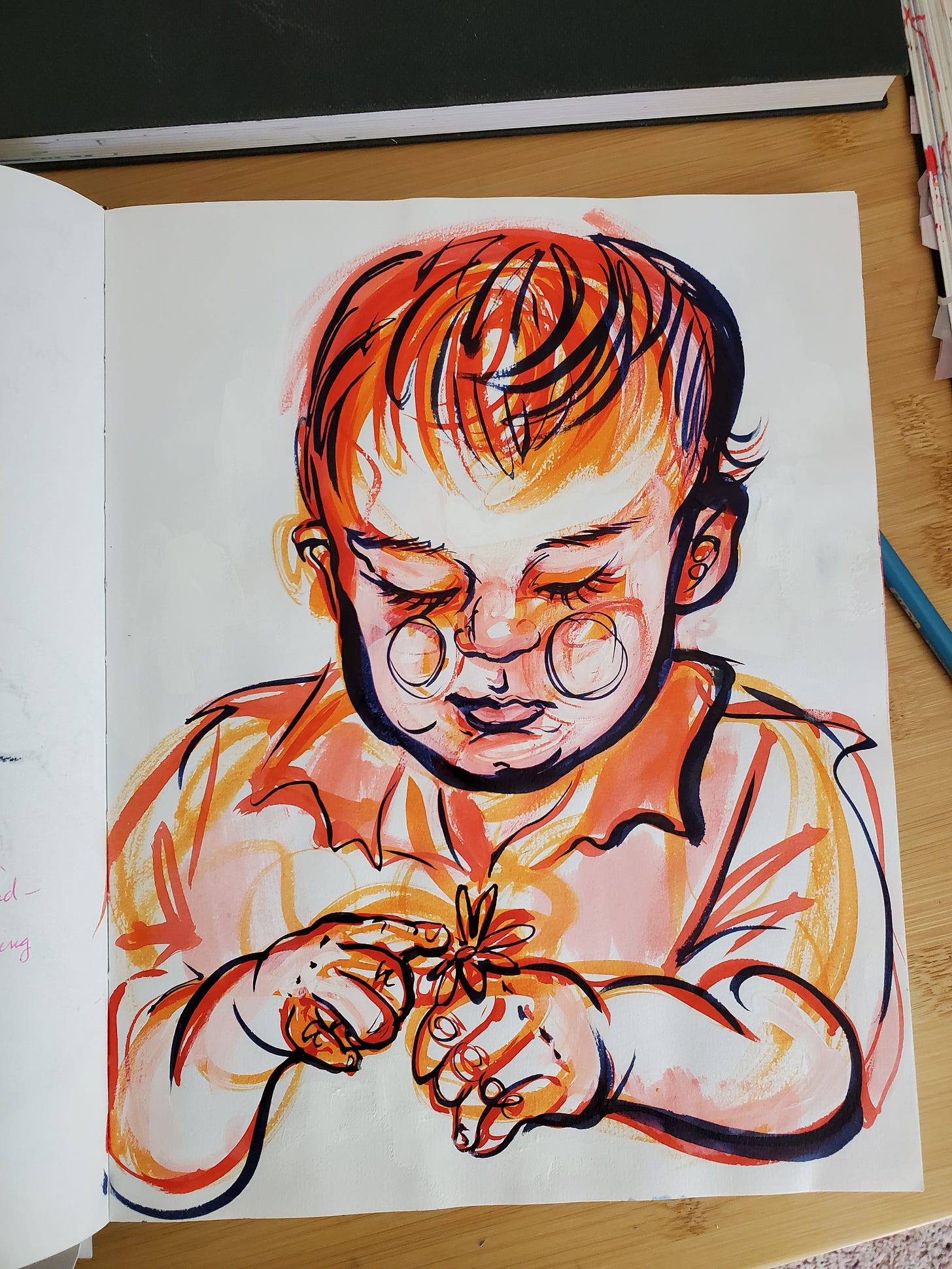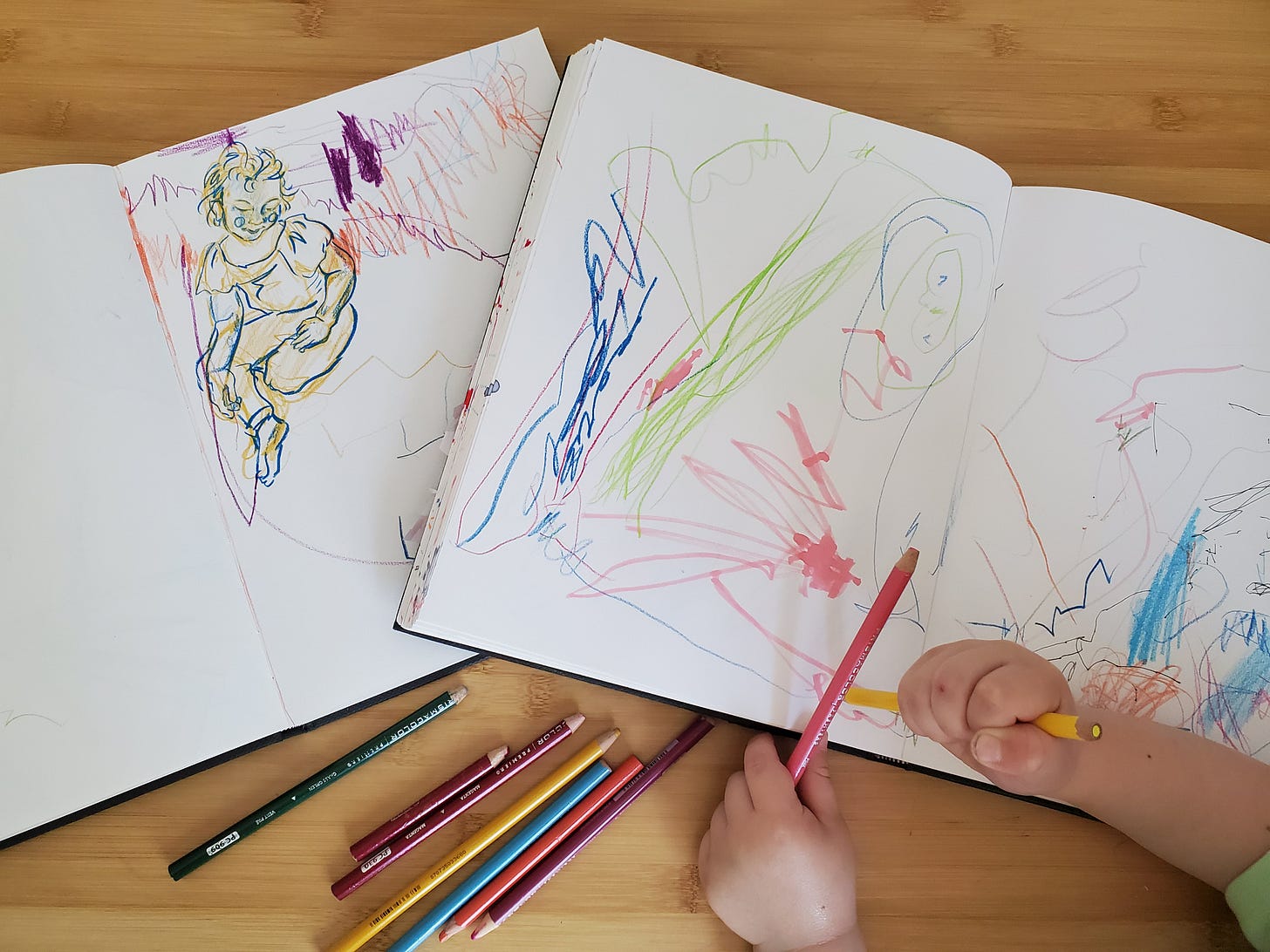Do We Even Know How to Feel Joy anymore?
The soft rebellion of feeling deeply.
My youngest son is curled into my chest, sleeping soundly as we soak in the late afternoon light. In front of me, my toddler capers from one clover patch to another, dodging bumblebees as he plucks flowers. “Beautiful flowers for Daddy!” he cries, pressing bald dandelions and ragged grass into my hand, before scampering off again.
This moment is joy.
But even as it lands, a question echoes in the background:
“Do we even know how to feel joy anymore?”
There’s a part of me that connects with that question all too well. The world feels like it’s cracking under the weight of too much: too much noise, too much grief, too much endless content. When anxiety and fatigue have us in a chokehold, joy can feel trite. Just another marketing tool, clickbait–childhood nostalgia repackaged to sell us more products.
And yet–joy found me in adulthood.
I often wondered if perhaps joy wasn’t made for people like me–people wired to survive, not to feel. As a child I was alert, anxious, and always waiting for the next crisis. Like any kid, I was playful, and I had a strong sense of wonder. But the kind of joy that resonates deep in your core was rare. And when it did come, it was undercut by a warning: brace for impact.
How could joy land when I couldn’t let my guard down?
Adulthood brought me home. Not all at once, not easily, and not all the time.
But slowly, in a thousand small shifts—joy became a quiet visitor. Almost shyly, it slipped through the cracks.
It’s trendy to talk about the “healing journey,” but it’s less trendy to acknowledge how brutal that process actually is. “Feeling your feelings” sounds good in theory–until you’re heaving sobs onto your bedroom floor, unraveling under the weight of something that happened twenty years ago.
I expected the pain. What I didn’t expect was that numbing myself was also stealing my joy.
That was the shock that knocked me off my feet–joy, like pain, requires vulnerability.
And vulnerability can’t happen when your body is stuck in survival mode.
Neuroscience tells us that joy isn’t just a feeling—it’s a physiological state. One we have to feel safe enough to enter. The vagus nerve, our body’s social-emotional highway, is always scanning for danger. If it senses threat–real or perceived–it calls in the cavalry: fight, flight, freeze, fawn. Our bodies become tense. We armor up. Shut down.
Only when that internal alarm quiets—when our body believes it is safe—can we soften into the soft glow of connection.
If joy is a state of being, vulnerability is the vehicle. Safety is the doorway.
For those of us shaped by early trauma, that doorway can feel locked from the inside. We’re not too broken to feel joy–we’re just hyper-attuned to danger. Even good things feel like a setup. The deep wisdom of our body, meant to protect us, has been called into overdrive–shutting down before we can even register what we’re supposed to be guarding against.
But it’s not just world-shattering Trauma that severs our ability to be present. Our nervous systems respond to absence as strongly as danger. A thousand tiny wounds–pressure, stress, inconsistency–can shape a nervous system as much as one violent rupture.
Now, add the era of chronic overwhelm. Breaking news, relentless scrolling, and the expectation to always be “on” create our baseline. Our systems are more dysregulated than ever. And when clicks equal profit, even our most sincere attempts to connect get commodified.
Sign this petition. Share this post.
Like, follow, argue.
If you pause, you’re complicit.
If you turn away, you don’t care.
We’re told that to care is to stay plugged-in. But somewhere in the noise, we lose the very thing we’re fighting for: connection.
So we cope the only way we know how. Caffeine to wake up. Alcohol to wind down. Dopamine on repeat–anything to feel something.
This isn't regulation. It’s survival.
And it's not weakness–it’s wiring.
Stillness, for so many of us, feels dangerous.
The thing about growing up in survival mode is that you learn to live on high alert—always scanning the horizon. Exhausted, but wired. In a twisted sort of way, it feels like home.
And the internet? Taps right into that frequency. The endless scroll, the cascade of disasters, hot takes, ads, and proof that everyone you know has a better life than you–all before your morning coffee.
This overdrive mirrors that old survival state—eyes peeled wide to take in the horror, rest always just out of reach. It’s a different battlefield, but the same result: disconnection.
Trauma and burnout pull us out of our body, out of the moment, away from anything steady or real. And in that state, joy doesn’t stand a chance.
For a long time, I didn’t even realize that joy was missing. I was too busy managing the noise.
But something shifted—not in grand, cinematic moments, but imperceptible ones. A breath I didn’t have to fight for. A flicker of grounding. A presence I could trust.
I used to think joy would come after the healing—a reward for getting it “right.”
But that’s not how it showed up.
For me, joy found me in the tentative trust that I began to build in my body. It came in a moment of stillness that didn’t feel dangerous. The sun on my skin. My husband’s hand in mine. A laugh that rose up without guilt.
It was the consequence of learning to be present.
Of beginning to inhabit my life again–in my body, here, now, in this moment.
Much has been written about the difference between joy and pleasure—but this isn't just philosophical–it's biological. Joy arises in a calm nervous system, and it regulates in return.
But pleasure sought in a dysregulated state? That’s not nourishment. It’s an escape.
We tell ourselves we’re indulging, when really we’re numbing. Like the drive to connect through endless scrolling, our impulses can become a kind of self-betrayal–cutting us off from the very thing we’re seeking.
We throw ourselves on the roller-coaster looking for a thrill, when what we need is a soft landing. The ground beneath our feet. A place to rest. To anchor. To reconnect.
When rooted in connection and safety, pleasure is sacred. It’s not the enemy of joy–it’s the extension of it.
All this sounds nice in theory. Thanks for the Mary Oliver poem, but real life is calling. My toddler is melting down. My phone has 7,835 notifications. And, oh yeah–the world is burning.
Where’s my third iced coffee of the day?
I’m not writing this because I’ve got it figured out. I don’t. I struggle with being over-caffeinated, under-slept, and feeling totally out of touch with my body more often than I care to admit.
But in a world that increasingly blurs the line between consuming content and being consumed, we need to learn to value attunement over attention.
Joy sounds like a bonus–a luxury for the privileged. But nothing could be further from the truth.
Joy is the deep well inside all of us, just waiting to overflow–if only we are still enough, connected enough, to listen.
It’s not the absence of pain or fear. It’s not a reward for healing.
It’s a return. A full-bodied “yes” to this moment. To ourselves.
And in a culture that thrives off our depletion?
Joy isn’t a luxury. It’s a form of resistance.
This culture doesn’t want you regulated. It wants you to be reactive. A nervous system stuck in survival can’t create, can’t connect, can’t care with any real depth.
We need safety—not just for ourselves, but for the world we’re trying to build.
For me, joy is not about “feeling good.”
It’s about returning—
to my body.
To this moment.
To the people I love.
To myself.
In a world that profits off our disconnection, that return is nothing short of radical.
Joy doesn’t always burst through the door. Sometimes, it slips quietly through the cracks.
I’m learning to leave those cracks open.
Sources
Porges, Stephen W. "Polyvagal Theory: A Science of Safety." Frontiers in Integrative Neuroscience, vol. 16, 2022, https://www.frontiersin.org/articles/10.3389/fnint.2022.871227/full.
This article discusses the Polyvagal Theory, emphasizing the role of the vagus nerve in regulating states of defense and promoting safety, which is foundational to understanding how our nervous system influences emotional states like joy.
"Vagus Nerve." Psychology Today, https://www.psychologytoday.com/us/basics/vagus-nerve.
This entry explains the vagus nerve's function in relaxing tension and downregulating stress responses, facilitating a state of calm necessary for experiencing joy.
Stillman, Jessica. "How to Boost Your Emotional Intelligence With 'Joy Conditioning'." Inc., 3 April 2025, https://www.inc.com/jessica-stillman/neuroscience-says-joy-conditioning-is-the-most-pleasant-and-effective-way-to-boost-your-emotional-intelligence/91168241.
This article explores the concept of 'joy conditioning' and how engaging with positive memories can regulate emotions and enhance emotional intelligence, aligning with the idea that joy requires a sense of safety.
"The Effects of Joy on Your Body." Healthline, 25 July 2018, https://www.healthline.com/health/affects-of-joy.
This piece outlines how joy triggers the release of neurotransmitters like dopamine and serotonin, contributing to feelings of happiness and well-being.
Schwartz, Arielle. "The Vagus Nerve in Trauma Recovery." Dr. Arielle Schwartz, 19 September 2019, https://drarielleschwartz.com/the-vagus-nerve-in-trauma-recovery-dr-arielle-schwartz/.
This article discusses how stimulating the vagus nerve through breath and movement practices can help restore a sense of safety and aid in trauma recovery, highlighting the connection between nervous system regulation and the capacity for joy.
"The Vagus Nerve's Mysterious Role in Mental Health Untangled." Scientific American, 1 January 2025, https://www.scientificamerican.com/article/how-the-vagus-nerve-could-influence-physical-and-mental-health/.
This article delves into the vagus nerve's extensive influence on mental health, including its role in detecting bodily signals and promoting calmness, which are essential for experiencing positive emotions.







